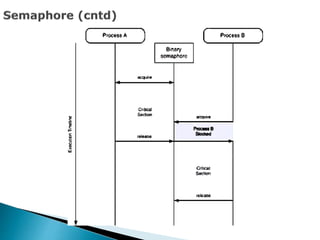Lecture18-19 (1).ppt
- 2. Previously we studied a software based solution to critical section problem (Peterson solution). Many systems provide hardware support for critical section code. Uniprocessors – We could disable interrupts for preamption so when a shared data is being modified no preamption will occur. ◦ Generally too inefficient on multiprocessor systems. Disabling interrupts on a multiprocessor is very time consuming, as the message is passed to all the processors Modern machines provide special atomic hardware instructions Atomic = non-interruptable
- 3. The important characteristic is that this instruction is executed atomically. If two TestAndSet C) instructions are executed simultaneously (each on a different CPU), they will be executed sequentially in some arbitrary order. boolean TestAndSet (boolean *target) { boolean rv = *target; *target = TRUE; return rv: }
- 4. If the machine supports the TestAndSet () instruction, then we can implement mutual exclusion by declaring a global Boolean variable lock, initialized to false. Solution using TestAndSet Shared boolean variable lock is initialized to false. do { while ( TestAndSet (&lock )) ; /* do nothing // critical section lock = FALSE; // remainder section } while ( TRUE);
- 5. Another synchronization tool is called semaphore. A semaphore S is an integer variable that is accessed only through two standard atomic operations: wait () and signal (). Wait is represented by P() and signal by V().
- 6. Binary semaphore – integer value can range only between 0 and 1; can be simpler to implement ◦ Also known as mutex locks Counting semaphore – integer value can range over an unrestricted domain. ◦ Used to control access to a given resource consisting of a finite number of instances. ◦ Semaphore is initialized to the number of resources available. Each process performs a waitQ operation on the semaphore (thereby decrementing the count). ◦ When a process releases a resource, it performs a signal () operation (incrementing the count). ◦ When the count for the semaphore goes to 0, all resources are being used. After that, processes that wish to use a resource will block until the count becomes greater than 0.
- 7. Mutual Exclusion We can use binary semaphores to deal with the critical-section problem for multiple processes. The n processes share a binary semaphore (mutex lock) initialized to 1. Each process P, is organized as shown ◦ Semaphore S; // initialized to 1 ◦ wait (S); Critical Section signal (S);
- 9. Implementation– Main disadvantage of the semaphore definition given previously is that every process waiting for semaphore loops continuously in the entry code. Looping wastes CPU cycles that some other process might be able to use productively. This type of semaphore is also called a spinlock (process "spins" while waiting for the lock). To eliminate busy waiting when a process has to wait for semaphore it is blocked. The block operation places a process into a waiting queue associated with the semaphore. Hence a waiting process is not scheduled so no cpu cycles are wasted.
- 10. Implementation– semaphores under this definition is defined as a "C" struct: typedef struct { int value; struct process *list; } semaphore; Implementation of wait: wait (S){ S->value--; if (S->value < 0) { add this process to waiting queue block(); } } Implementation of signal: Signal (S){ S->value++; if (S->value <= 0) { remove a process P from the waiting queue wakeup(P); } }
- 11. The block() operation suspends the process that invokes it. The wakeup(P) operation resumes the execution of a blocked process P. These two operations are provided by the operating system as basic system calls. Note that, although under the classical definition of semaphores with busy waiting the semaphore value is never negative, this implementation may have negative semaphore values. If the semaphore value is negative, its magnitude is the number of processes waiting on that semaphore.
- 12. Deadlock – two or more processes are waiting indefinitely for an event that can be caused by only one of the waiting processes Let S and Q be two semaphores initialized to 1 P0 P1 wait (S); wait (Q); wait (Q); wait (S); . . . . . . signal (S); signal (Q); signal (Q); signal (S); Starvation – indefinite blocking. A process may never be removed from the semaphore queue in which it is suspended. May occur if we add and remove processes from the list associated with a semaphore in LIFO (last-in, first-out) order.











